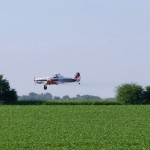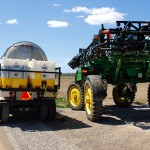Reading Time: 8 minutes The term has been around for decades, and it trips off our tongues as easily as “no-till management” and “cover crops.” Yet one of the challenges, even for those in search of a silver bullet in crop management, is the constant evolution of the term “IPM.” Its meaning is rapidly evolving, and so are the […] Read more

The Integrated Pest Management (IPM) challenge for today’s crops
Are you keeping on top of all these new pest-control opportunities?

Pest Patrol: How do I control tansy ragwort in my pasture?
#PestPatrol with Mike Cowbrough, OMAFRA
Reading Time: 2 minutes By Kate Ayers University of Guelph, Ontario Agriculture College Tansy ragwort is a noxious weed most often found in pastures and hayfields. It is a biennial or short-lived perennial that reproduces through seeds and roots. Tansy is poisonous to livestock and can cause liver damage. Symptoms that may occur after plant consumption include: weakness, high […] Read more

Pest Patrol: Using the ‘Pest Manager’ app
Weeds and weed management information in the palm of your hand
Reading Time: 2 minutes We have good pest management information and research. The challenge can be to get that information to the farmers who need it. Earlier this summer, a smartphone app was launched called Pest Manager. Currently, only information on weeds and weed management is included, so I tell farmers it’s what you would get if a weed […] Read more

Is the sky the limit for aerial spray applicators?
Caught between rigid government regulations and undependable farm demand, these aerial applicators wonder about their future
Reading Time: 6 minutes We all look when we hear them. The sound of an airplane or helicopter sprayer is as distinctive as it is enticing. With an airplane, there’s that telltale roar of its high-powered engine and the pitch-shifting Doppler-effect. With a helicopter, there’s the unmistakable vibration stirring the air as it races from one end of a […] Read more

U.S. EPA proposing temporary pesticide-free zones for honeybees
Reading Time: 2 minutes Reuters — U.S. environmental regulators on Thursday proposed a rule that would create temporary pesticide-free zones to protect commercial honeybees, which are critical to food production and have been dying off at alarming rates. The restrictions are aimed at protecting bees from “pesticides that are acutely toxic” to them, and would cover foliar applications when […] Read more

Controlling crop weeds with beneficial insects
Flea beetles that eat leafy spurge are only the first wave of biological weed control
Reading Time: 5 minutes What is it about weeds? No matter how hard you try to eradicate them, they always come back. Worse still, each method of weed control has its drawbacks. Spraying with herbicides can lead to weed resistance if the same product is used continuously. Tillage can result in soil erosion (remember the Dirty ’30s?), and although […] Read more

Making the case in the neonic debate
Can agriculture afford to lose to the non-science of neonic opponents? The costs would be even higher than you probably think
Reading Time: 13 minutes Here in early 2015, it’s becoming a recognized pattern in agriculture: another day, another article, another proclamation and another call for action, all revolving around farmers’ use of neonicotinoid seed treatments and the alleged damage this does to bees and bee colonies. To say there is an abundance of information on this topic is one […] Read more

Pesticides could lead to ‘pollination deficit,’ EU report says
Reading Time: 2 minutes Brussels | Reuters –– Evidence is mounting that widely-used pesticides harm moths, butterflies and birds as well as bees, adding to concerns crop production could be hit by a shortage of pollinators, according to a report drawn up for EU policymakers. The European Commission, the EU executive, placed restrictions on three neonicotinoid pesticides from Dec. […] Read more

Fungicide resistance creeping up in crops
Fortunately, we already have many of the tools we need to delay or stop resistance in its tracks
Reading Time: 5 minutes We hear a lot about herbicide-resistant weeds these days. Repeated use of herbicides, especially ones from the same group and with similar modes of action, promotes the growth of weed populations that the chemicals can no longer control. A prime example is the emergence of weeds resistant to glyphosate, the most widely used weed control […] Read more

Drift versus volatility when spraying your crop
Spraying on a quiet, still morning is the best way to cut your drift risk, right? (Answer: No!)
Reading Time: 7 minutes Just when farming already seemed complicated enough, here are more misconceptions that science is disproving. Except this time, the new findings will help more growers get more value from their crop protection dollar. The best part is, you’re probably one of those growers too. Drift — Physical Trying to paint drift as worse than volatility, […] Read more


